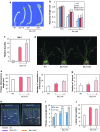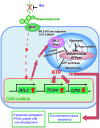A novel mitochondrial DnaJ/Hsp40 family protein BIL2 promotes plant growth and resistance against environmental stress in brassinosteroid signaling
- PMID: 23494613
- PMCID: PMC3664749
- DOI: 10.1007/s00425-013-1859-3
A novel mitochondrial DnaJ/Hsp40 family protein BIL2 promotes plant growth and resistance against environmental stress in brassinosteroid signaling
Abstract
Plant steroid hormones, brassinosteroids, are essential for growth, development and responses to environmental stresses in plants. Although BR signaling proteins are localized in many organelles, i.e., the plasma membrane, nuclei, endoplasmic reticulum and vacuole, the details regarding the BR signaling pathway from perception at the cellular membrane receptor BRASSINOSTEROID INSENSITIVE 1 (BRI1) to nuclear events include several steps. Brz (Brz220) is a specific inhibitor of BR biosynthesis. In this study, we used Brz-mediated chemical genetics to identify Brz-insensitive-long hypocotyls 2-1D (bil2-1D). The BIL2 gene encodes a mitochondrial-localized DnaJ/Heat shock protein 40 (DnaJ/Hsp40) family, which is involved in protein folding. BIL2-overexpression plants (BIL2-OX) showed cell elongation under Brz treatment, increasing the growth of plant inflorescence and roots, the regulation of BR-responsive gene expression and suppression against the dwarfed BRI1-deficient mutant. BIL2-OX also showed resistance against the mitochondrial ATPase inhibitor oligomycin and higher levels of exogenous ATP compared with wild-type plants. BIL2 participates in resistance against salinity stress and strong light stress. Our results indicate that BIL2 induces cell elongation during BR signaling through the promotion of ATP synthesis in mitochondria.
Figures












References
-
- Asami T, Mizutani M, Fujioka S, Goda H, Min YK, Shimada Y, Nakano T, Takatsuto S, Matsuyama T, Nagata N, Sakata K, Yoshida S. Selective interaction of triazole derivatives with DWF4, a cytochrome P450 monooxygenase of the brassinosteroid biosynthetic pathway, correlates with brassinosteroid deficiency in planta. J Biol Chem. 2001;276:25687–25691. doi: 10.1074/jbc.M103524200. - DOI - PubMed
-
- Belkhadir Y, Wang X, Chory J (2006) Arabidopsis brassinosteroid signaling pathway. Sci STKE 2006(364):cm5 - PubMed
Publication types
MeSH terms
Substances
LinkOut - more resources
Full Text Sources
Other Literature Sources
Molecular Biology Databases

